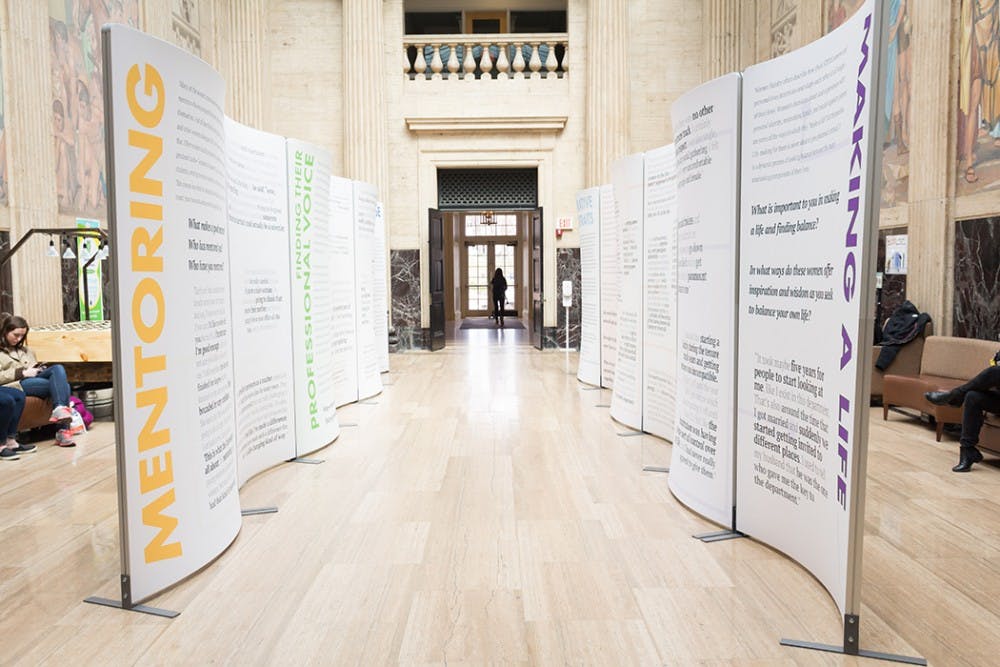U.Va. CHARGE — a University program that seeks to advance women in STEM — recently set up an exhibit in both the Chemistry Building and Clark Hall, highlighting the history, challenges and successes of women at the University. Carol Mershon, Politics Prof. and Interim Program Director, says the idea for the display stemmed from interviews conducted for the Voices and Visibility project — a campaign created to understand the stories of University women.
Mershon says that after conducting interviews with women faculty engineers, scientists and social scientists, the group wanted to share the inspiring words of their colleagues with all members of the University.
The exhibit in Clark Hall features a timeline documenting the status of women and their rights at the University. At one point the Honor Code was used to exclude women from enrolling, arguing that only white males possessed honor.
“Women have no honor, only deception,” a male University student said in 1967 from the exhibit. “They would undermine the honor system.”
Along with the timeline, the exhibit provides quotes from some of the University’s first female students, underscoring their feelings of inferiority.
“Something that really shocks me about this timeline is that the 1970s weren’t too long ago, and that’s when women were given the ability to openly enroll here,” third-year College student Jay Patel said. “It really shows you that gender equality is a fairly new concept, even in America.”
More recent cases of gender discrimination are also depicted on the display, such as a recent remark by Tim Hunt, recipient of the Nobel Prize in Physiology or Medicine. At a conference in 2015, Hunt implied that women working in labs are distracting and respond emotionally when criticized. The display shares pictures of women scientists replying to his claim with humorous images and sarcastic captions along with the hashtag “#distractinglysexy.”
The exhibit also highlights the story of platform engineer Isis Wenger, who in 2015 received demeaning comments from men who insisted that she was “too pretty” to be an engineer.
“An exhibition like this is very important, because it informs and reminds us that even though society, including [the University], has made some progress towards gender equality in education, we still have a long way to go because the issue of gender inequality still exists today,” third-year College student Sophia Ryuh said.
The other half of the physical exhibit in the Chemistry Building highlights female staff from the University, including Electrical and Computer Engineering Prof. Malathi Veeraraghavan.
Mershon hopes the displays shed light on sexism as an ongoing battle and how the University accommodates many honorable women who participate in STEM fields.
“First, I hope that [viewers of the exhibit] reflect on the experiences of the women faculty in the exhibit,” Mershon said in an email to The Cavalier Daily. “This may seem like quite a simple message, but it is not. It can be challenging and difficult to pay attention to — to listen to — the voices of people who are unlike you and who have experiences unlike yours.”
Mershon also said many University STEM departments hold women’s caucuses and have mentorship programs to help connect faculty and undergraduate females. The University also started a new program called Directors of Diversity and Inclusion to bring faculty from the College together to help promote diversity and inclusivity for all races and genders.
“I hope that students and faculty visiting the exhibit recognize the important contributions to [the University] made by women natural scientists, social scientists and engineers,” Mershon said. “I hope that visitors to the exhibit recognize and reflect on what and how much it takes for women to succeed in a male-dominated environment that can be biased toward women and other members of underrepresented groups.”







